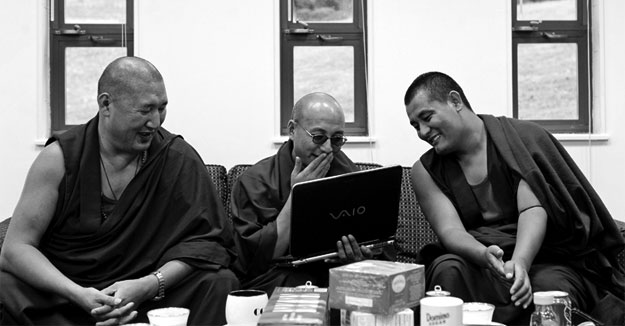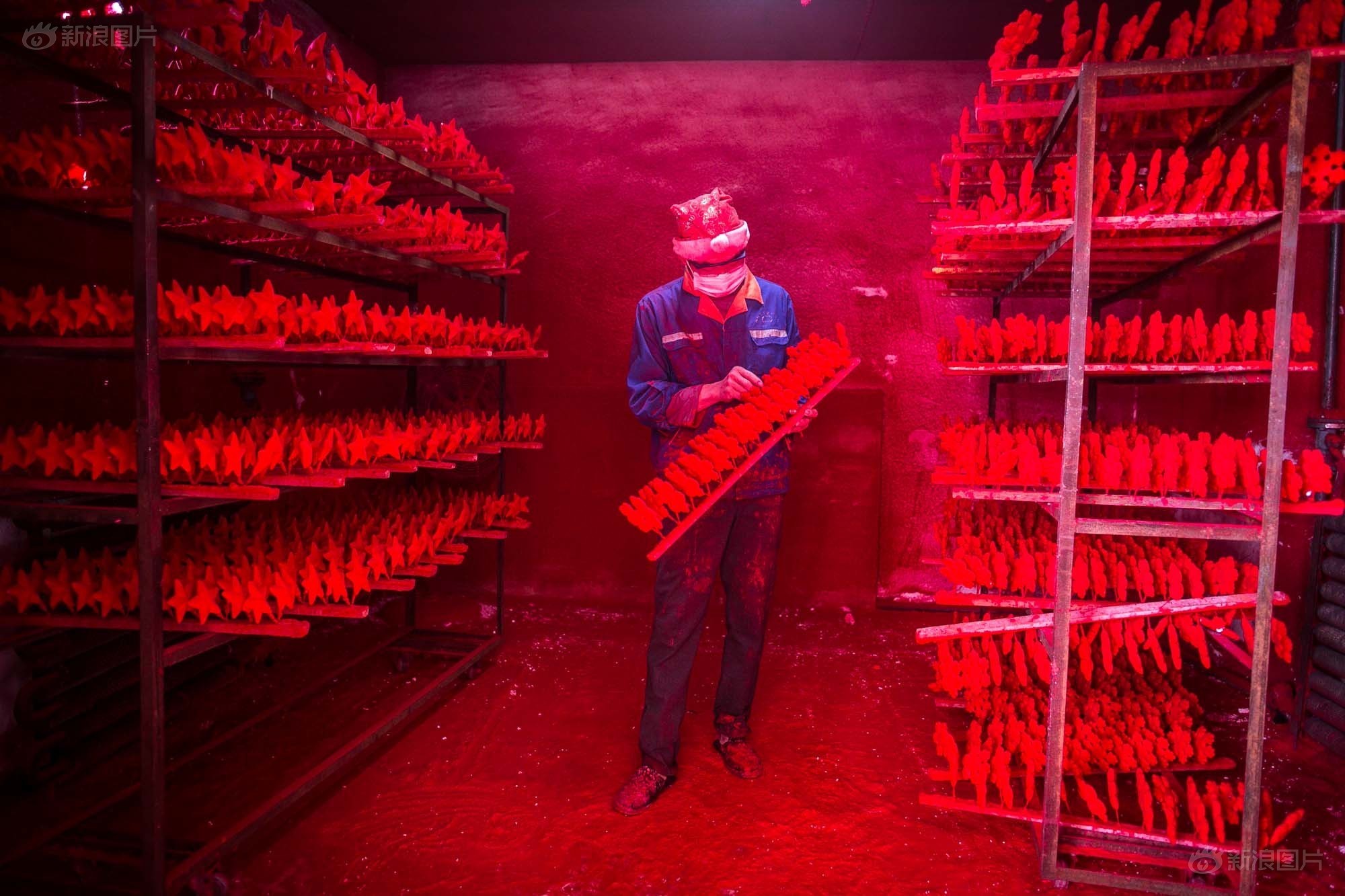Images by Stan Aron
It's the off-season and 55-year-old family hotel owner, Xu Xiurong, is standing beneath a two-meter-high wooden sign that reads: ‘Simatai Traditional Heritage Village Welcomes You’.
But Xu’s hotel, like the Simatai village it is intended to help service, is neither traditional nor does it have any real heritage. It is brand new – built in a style never before found in northern China.
Two years ago, Xu was one of the several hundred local people who were relocated to the new village after their old homes, built around the Simatai area of the Great Wall, fell within an area demarcated for the development of northern China’s first and only water town.
The Ancient Gubei Water Town, as it is now officially known, sits several kilometers further up the mountain from Xu’s hotel, amid a network of newly built canals and rivers.
After four years of construction, Gubei was officially opened to tourists this October, though work continues throughout the town. As a salesperson in the Gubei gift shop at the entrance of the town tells us: “Of course it takes a lot of time to demolish all the old houses, clean up all the things people who lived here left behind, and rebuild new stuff according to the ancient blueprint.”
That ancient blueprint – if there is in fact such a thing – is likely to have been borrowed from Suzhou. With its narrow flowing canals, stone streets, wooden houses, small arch bridges and carved window frames, Gubei bears a striking resemblance to the famed southern water city.
During the APEC holiday, hundreds of tourists descended on Gubei, lured by promotional advertisements promising: “Over a thousand years of authentic heritage.” Though many claimed to be disappointed by the fact that nobody was actually living within the town itself, the majority appeared satisfied with the overall experience and level of authenticity.
“You can easily imagine that you are in Suzhou, and it’s far cheaper and more convenient than actually making the journey south,” says Mr Xu, a 28-year-old engineer, who along with his colleagues, is visiting the town as part of a team-building exercise. “Anyway, tourism is more about feeling. Nobody takes a magnifying glass on holiday to check what is original and what is fake.”
Indeed, there is no doubting Gubei is picturesque. The houses are imaginatively designed, the canals appear remarkably clean, and golden ginkgo leaves fall gracefully all around.
But a closer look reveals the town’s somewhat superficial nature. On the waterside, workers are building a traditional-style house, but beneath the wooden exterior lays steel and cement. One of them is smearing mud onto a wall to create the illusion of something well-worn. On each outer wall, red and yellow creepers elegantly wind around gray and white bricks, but again, on closer inspection it is apparent that they are attached with iron rings to dictate the direction in which they grow.

Tourists watch a traditional acrobatics show in Gubei
Beautiful or not, the town’s promotional claim that “everything in it, whether the rows of ancient houses, the peaceful hutongs or the old streets built with gray stone, display the authentic look of old northern China” is extremly doubtful. Former residents such as the hotelier Xu are now required to pay RMB150 to enter the town where their ancestors lived for hundreds of years. “The Great Wall was just like a wall in my yard,” says Xu. “Now it costs an additional RMB40 to even walk on it.”
For the former inhabitants of the town, their fate was sealed in the spring of 2010, after they were visited by a group of local government officials scouting for development locations. “I knew our village had tourism potential, thanks to our existing canal and, of course, the nearby Great Wall,” explains Xu. “But why transform it entirely into a ‘historic’ water town?”
But to Gubei’s developers, the question was irrelevant. Creating a false sense of history is now a common task in China’s tourism industry. In Gubei’s case, a deal was soon struck with the local government to maximize the profit generated from the site by transforming it from a loosely-controlled attraction into a themed site. The villagers also featured in the plans. They would be required to give up their land, move to new houses and make their income from regulated tourism-related businesses.
Ni Fengquan had lived in the old Simatai village for 46 years before the all-too-familiar offer was made. He would be compensated with RMB2,000 for each of the 170 square meters of his house, plus some additional money for his fruit trees on the mountain. Anyone with farmland was promised RMB2,000 a year for every acre lost. The government would build the villagers new houses but they would have to be purchased using the compensation payments.
Ni bought a very small apartment to save money and “feel safer”. Nonetheless, the remaining money was not enough to set up a homestay business, as some of the other relocated families have.
“I never wanted to move. And as far as I know, most of the other villagers were not keen on moving out either. Our ancestors had their reasons when they chose that site for the village. It has the best water resources, the best sunshine, and the best temperature. We had our own yards and big houses to run our own tourism businesses by the Great Wall,” he explains. “None of the new town is in any way real.”
The historical inconsistencies are glaring, according to Wei Xiang, director of the Leisure Tourism Research Center based in Beijing International University. While admitting that he admires the project’s beauty, Wei considers it more like a theme park with an injection of Chinese cultural tropes, rather than an accurate portrayal of ancient life. “Northern China has no water towns. It is a copy of Wuzhen, the famous water town in Zhejiang,” he explains.
Sitting at the far frontier of China’s ancient empire, Simatai was the only part of the Great Wall by flowing water. Prior to the developers’ arrival, there were already as many as 300,000 yearly visitors to the area.
Nonetheless, Lian Zifeng, Investment Deputy Director of China CYTS Tours Holding Co. Ltd., one of the project’s investors, admitted he was thrilled when he heard of the plans to build a water town. The businessman immediately turned his mind to the question of how to develop it.

The new Simatai village built to rehouse former Gubei residents
The relocation packages may offer new homes and apparent improvements to people’s quality of life, but the long-term benefits are less clear, argues Beijing International University’s Wei Xiang.
“The common practice is giving farmers some short-term benefit, like paying them money in a one-off package,” he says. “Although it looks, on the surface, as if the farmers’ living standards have been improved, their ability to develop sustainably is damaged.”
Nor have all of the relocation pledges been honored, Ni claims. He interviewed for one of the 3,500 positions opened to the villagers when the water town was completed, but was unsuccessful. “We don’t enjoy special treatment in the hiring process as they promised,” he says. In fact, none of the employees we speak to in the water town are previous inhabitants of Simatai village.
But not all are as disillusioned as Ni. Mr Chen, 45, who now lives in a village a few hundred meters away from the water town and is employed to row visitors around in a boat, identifies himself as one of the project's beneficiaries. A former fisherman and chestnut farmer, Chen is proud to have a job that “provides money, no matter what the weather or whether there are fish in the Miyun reservoir”.
“The canal is real, not like the architecture. And look at that waterfall, it is manmade. Isn’t it amazing?” Chen asks proudly, pointing to a popular spot for photographs as he ferries us around the town’s waterways. “People in Miyun have already sacrificed enough for Beijing’s prosperity,” Chen argues.
“We don’t have a factory and I heard that in 15 years’ time, to protect the environment, even raising poultry will be forbidden. Without developing tourism, what else can Miyun do? I neither understand nor care about people’s standards on ‘real culture’. I only know I benefit from the changes.”
Inside one of the town’s traditional southern China snack restaurants, the proprietor leans on a black wooden table waiting for guests as smoke curls up from an antiquated-looking stove. After three months of training, she is expected to provide tourists with an authentic experience of southern cuisine. Next door, 39-year-old Zhao Bao and three other workers are busy painting an advertisement board. In 1999, Zhao also worked on the Wuzhen Water Town project in Zhejiang, which provided the model for Gubei.
“This water town is much bigger but, otherwise, almost the same as Wuzhen,” he says.
According to Zhao, to build a project like Wuzhen was unusual in the 1990s but in recent years, he has worked on many similar developments around China. Statistics shared with us by Professor Wu Bihu from Peking University suggest that by the end of 2012, no less than 30 cities had joined, or were planning to join, the new wave of ‘ancient’ town construction. These often pose grave threats to the pre-existing (and genuine) ancient environments.

Wei Xiang and his team at Beijing International University’s Leisure Tourism Research Center claim to have been unable to find any instances of ancient town developments that successfully preserve traditions. “They all depend too much on commercialization,” Wei suggests. “The only thing that makes them different from one another is which fakes look real and which fakes are more obviously fake.”
But, in Gubei at least, the lack of genuine ancient culture seems not to have stopped people coming in droves from the capital. China CYTS Tours Holding Co. Ltd., reports that 776,300 tourists visited the water town in the first three quarters of this year, generating revenue in excess of RMB145 million, far beyond expectations.
Surrounding businesses are also reportedly galvanized by the development. We find a salesman for Longfor Real Estate Group, which owns a high-end residential compound inside the water town, trying to convince an old couple to invest. “It’s common for a Beijing family to have two or three houses,” he tells them. “One more house here will be the best choice for your retired life.” The couple do not seem entirely convinced but still leave a phone number.
“The revenue from the tickets will not cover the investment in the project. In the long-term, it’s more a real estate program rather than a tourism program," says Wei Xiang. “I’m concerned about this phenomenon. As China tightens restrictions on real estate development and land policy, some developers are, in the name of tourism, essentially resource-grabbing. Towns like Gubei are easy to copy at little expense. But developers rarely care if it is the right decision for the area.”
Back in the Simatai residents’ new village, Ni Fengquan is checking the water passing downstream from Gubei. He frowns, complaining that it’s getting “worse and worse”. Ni claims that the new hotels and restaurant are simply pouring their waste water into the canal which dirties the supply used by dozens of surrounding villages. He points to three rows of half-demolished houses encircled by a blue iron protective fence.
On a dilapidated wall, a slogan pasted on during the Cultural Revolution is still visible. A deep, black ash on the bricks of the hearth serves as a reminder of the generations of families that had cooked by it. Some eggplants still stand in the middle of the yard, dried, as if the inhabitants had left in a hurry. “Look, these are how the real old villages used to be like,” Ni says, turning toward home.






















0 User Comments